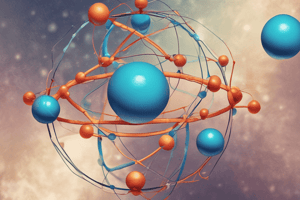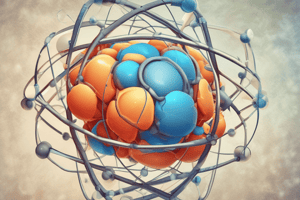Podcast
Questions and Answers
What does physical chemistry focus on?
What does physical chemistry focus on?
Which area falls under physical chemistry?
Which area falls under physical chemistry?
What does thermodynamics study?
What does thermodynamics study?
In physical chemistry, what does kinetics focus on?
In physical chemistry, what does kinetics focus on?
Signup and view all the answers
What does statistical mechanics apply probability theory to explain?
What does statistical mechanics apply probability theory to explain?
Signup and view all the answers
Which aspect of chemistry involves the investigation of matter and its transformations?
Which aspect of chemistry involves the investigation of matter and its transformations?
Signup and view all the answers
What is the primary focus of the field of electrochemistry?
What is the primary focus of the field of electrochemistry?
Signup and view all the answers
Which of the following subatomic particles is uncharged and found in the nucleus of an atom?
Which of the following subatomic particles is uncharged and found in the nucleus of an atom?
Signup and view all the answers
What is the principle that governs the behavior of matter at the atomic scale?
What is the principle that governs the behavior of matter at the atomic scale?
Signup and view all the answers
What does the atomic number (Z) represent?
What does the atomic number (Z) represent?
Signup and view all the answers
What property of an atom is responsible for its magnetic moment?
What property of an atom is responsible for its magnetic moment?
Signup and view all the answers
Which of the following atomic models was proposed by Erwin Schrödinger?
Which of the following atomic models was proposed by Erwin Schrödinger?
Signup and view all the answers
Study Notes
Chemistry: Understanding Physical Properties and Atomic Structure
Chemistry is a central science that deals with the investigation of matter and its transformations, including the substances that make up matter and the energy associated with these transformations. Two essential aspects of chemistry are physical chemistry and atomic structure. In this article, we will discuss these topics to help expand your understanding of chemistry.
Physical Chemistry
Physical chemistry focuses on studying the properties and behavior of matter at the macroscopic and microscopic scales. It includes areas such as thermodynamics, kinetics, statistical mechanics, electrochemistry, and interfacial phenomena. Here are some key concepts related to physical chemistry:
-
Thermodynamics: This branch of physics studies heat and work and their relation to energy, radiation, and properties of matter. Thermodynamic laws describe the relationships among internal energy, entropy, and pressure in a system.
-
Kinetics: Kinetics examines the rates and mechanisms of chemical reactions. It uses mathematical models to predict reaction rates under various conditions, providing insights into the factors affecting reaction speed.
-
Statistical Mechanics: Statistical mechanics applies probability theory to explain the thermal, electrical, magnetic, optical, and mechanical properties of materials at a macroscopic scale. It is used to derive equations for thermodynamic properties from statistical information.
-
Electrochemistry: This field of chemistry deals with the interaction between electricity and chemicals. It investigates the processes involving redox reactions, such as corrosion, electroplating, and batteries.
-
Interfacial Phenomena: Interfacial phenomena involve the study of how substances interact at the boundary between phases, such as solids, liquids, gases, and solutions. This includes surface chemistry, wetting, and adhesion.
Understanding these topics in physical chemistry helps to gain a deeper knowledge of the properties and behaviors of matter in various situations and contexts.
Atomic Structure
Atomic structure refers to the organization and arrangement of subatomic particles within an atom. It helps to explain the properties and behavior of matter at a more fundamental level.
Subatomic Particles
An atom consists of three types of subatomic particles:
- Protons: Positively charged particles with a mass close to 1 atomic mass unit (amu). They are located in the nucleus.
- Neutrons: Uncharged particles with a mass slightly less than that of protons. Like protons, they are found in the nucleus.
- Electrons: Negatively charged particles with a mass much lighter than protons or neutrons. They are located in energy levels or shells surrounding the nucleus.
These particles interact according to the laws of quantum mechanics, which govern the behavior of matter at the atomic scale.
Atomic Models
Over time, various atomic models have been proposed to better understand atomic structure. From Thomson's plum pudding model to Rutherford's planetary model, and eventually the Bohr model, these theories helped develop our current understanding of atomic structure, leading to the modern quantum mechanical model proposed by Schrödinger.
Isotopes and Atomic Numbers
Isotopes are atoms of the same element that have different numbers of neutrons in their nucleus. They have the same number of protons, known as the atomic number (Z), but varying numbers of neutrons, resulting in different mass numbers. The mass number (A) stands for the sum of protons and neutrons in the atom.
Electric Charges and Magnetic Moments
As mentioned earlier, electrons have a negative charge of approximately −1.602 x 10^(-19) coulomb, while protons have a positive charge of approximately +1.602 x 10^(-19) coulomb. According to the principle of conservation of electric charge, the number of electrons in an atom must balance the number of protons in the nucleus to maintain an electrically neutral atom, unless the atom has become charged, forming an ion.
In summary, understanding the basics of physical chemistry and atomic structure is essential for comprehending the fundamental principles underlying chemical phenomena. Through ongoing research and advancements in technology, our understanding of these topics continues to evolve, allowing us to discover new applications and applications in various fields of science.
Studying That Suits You
Use AI to generate personalized quizzes and flashcards to suit your learning preferences.
Description
Test your knowledge on physical chemistry concepts like thermodynamics, kinetics, and electrochemistry, as well as atomic structure topics including subatomic particles, atomic models, isotopes, and electric charges. This quiz will help reinforce your understanding of essential chemistry principles.




